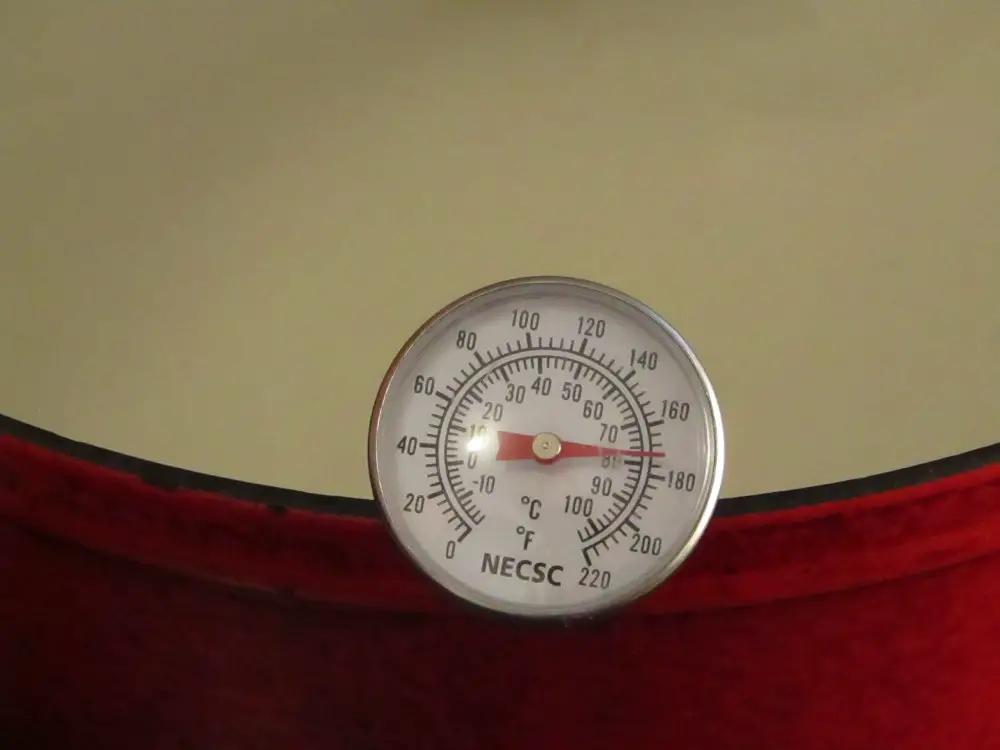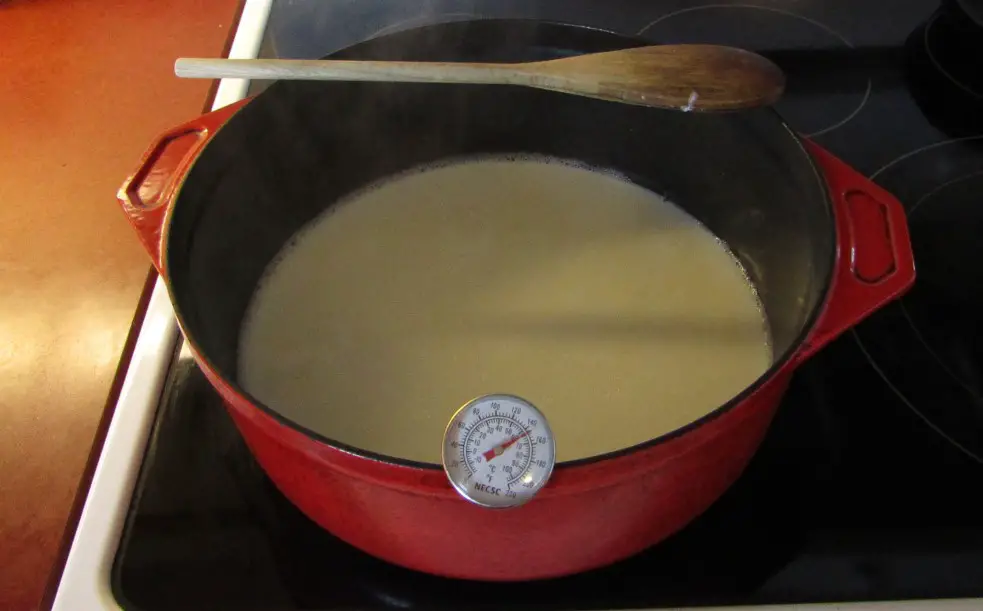This post contains affiliate links.
When making yogurt it is recommended that you heat the milk slowly in a pot until it reaches 85 degrees C. and then cool to the proper fermentation temperature. You may wonder why not just heat the milk to its fermentation temperature rather than heating it up so much and then letting it cool.
Milk is heated prior to the fermentation process of yogurt production to pasteurize the milk, denature some of the whey protein and to remove some of the water. This prevents spoilage during fermentation and makes a thicker yogurt.
To get the best results when making yogurt, having a good understanding of the processes which take place will help you to alter your yogurt making process to suit your needs. Heating the milk has several other affects which can alter the yogurts characteristics.
Most types of milk fermentation require heating the milk for various reasons but if you find this too bothersome you could always try making kefir. To learn the differences between yogurt and kefir check this article out here.
To pasteurize the milk
There are several types of pasteurization which is used in the milk industry which are differentiated by the temperature and time the temperature is maintained. With each successive increase in temperature there is an associated decrease in microbial activity in the milk.
- Minimum pasteurization
This type of pasteurization causes the least amount of changes to the milk. Although the temperature is higher than vat pasteurization it is maintained for only a short period of time.
The temperature reached is above 72 degrees C and held for 15 seconds.
This type of pasteurization is often done at the dairy before the milk is shipped to maintain its freshness and reduce the microbial count during storage.
- Vat pasteurization

This type of pasteurization is the most common method of pasteurization for yogurt making. It reduces the microbial population in the milk by destroying any active bacteria or mold. It has no affect on spores which are present in the milk but because the milk is inoculated with a live active yogurt culture the spores do not have a chance to sporulate and dominate the milk. For commercial vat pasteurization milk is heated to 80C/180F for 30 minutes.
- High temperature short time
High temperature short time pasteurization is performed at temperatures between 88 degrees C to 100 degrees C. with each successive increase in heat the time required is lowered.
Heating the milk to such high temperatures not only destroys the living microbes in the milk but also destroys the spores making for a longer shelf life for the milk but changing the chemical makeup of the milk, altering its flavor, benefits and behavior which is detrimental to the yogurt making process.
The goal of pasteurization is to give the yogurt culture the upper hand during the fermentation process. Once the culture has populated the milk the milk will begin to acidify making it uninhabitable for the unwanted microbial action to take place. By reducing the population of the unwanted microorganisms ensures the yogurt culture can grow unhindered.
To change some of the whey protein
There are two types of protein in milk, whey protein and casein. The casein protein is very stable due to its structure and remains unaffected by vat pasteurization. The whey protein structure is different and unfolds with the application of heat. This allows the protein to react with other components in the milk as it acidifies.
As the whey protein reacts with the other components in the milk it gels and forms a loose structure. This makes for a thicker yogurt which resists the separation of the curds and whey as the yogurt ferments.
To help reach correct fermentation temperature
When making yogurt there are two different types of yogurt starter cultures:
Thermophilic – requires above ambient room temperature
Mesophilic – requires room temperature
Both types require higher than refrigeration temperature which means that the milk needs to be heated before it is inoculated with the culture for best results. By heating it on the stove and then lowering the temperature to the correct fermentation temperature the starter culture will be able to begin fermenting the milk immediately.
If the milk is inoculated into cold milk and then heated to the proper fermentation temperature, spoilage bacteria can get a foothold and give the yogurt an off flavor.
To change some of the fat structure
As the milk is heated the fat in the milk changes its chemical structure making it easier to react with the whey protein in the milk. This improves the texture of the milk by making it creamier and thickens the yogurt further as the whey protein is included in the solids found in the milk.
High fat milk tends to make a thicker creamier yogurt with a smooth texture but by heating the milk it also increases the yogurts tendency to maintain its structure. This texture is more typical of commercial yogurt.
To improve the flavor
- Alters some of the enzymes and other flavor components
Yogurt can have a creamy caramel flavor which goes great with cereal, fruit or in dips and sauces. This caramel flavor is achieved through the heating process where the enzymes and other flavor components in the milk are altered. If the yogurt is heated properly only a few of these enzymes are changed leaving most in their natural state.
- Prevents unwanted flavors from microbial growth
If you have ever tasted food which has gone off you will know the affect spoilage bacteria has on the flavor of the food. It has a taste which is inherently unpleasant and ensures that you do not consume any more of it.
The thing is that all food has spoilage bacteria growing in it. Whether they come from the original source, the container or utensils used during fermentation or just from the air, they will be present. By heating the milk up you give the yogurt culture a head start which limits the amount of spoilage bacteria which can grow in the yogurt. This reduces any off flavors which are present in the yogurt.
To remove some of the water
When the milk is heated some of the water evaporates into the air. This makes for a thicker yogurt with a higher fat and protein content. The water in the milk is associated mostly with the whey which is the protein in the milk which helps the yogurt to thicken. With a lower ratio of water to protein the yogurt becomes thicker and more creamy.
To lower the pH
As milk is heated some of the chemical components break down and become more acidic. This helps to lower the pH of the milk prior to fermentation. With a lower pH at the start the yogurt is less susceptible to spoilage and will thicken faster than milk which is not heat treated.
The protein in the milk will begin to thicken once it reaches a pH of 4.6 and will get firmer as the pH drops. Once it gets low enough the whey in the milk will disassociate from the solids and separation will occur. Heated milk will thicken quicker than non-heated milk making for a shorter fermentation period.

